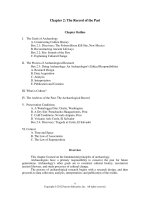Basic finance an introduction to financial institutions investments and management 11th edition mayo test bank
Bạn đang xem bản rút gọn của tài liệu. Xem và tải ngay bản đầy đủ của tài liệu tại đây (158.01 KB, 7 trang )
TEST BANK
This part of the Instructor's Manual presents a test bank
of true/false statements, multiple choice questions, and,
where appropriate, additional problems. The problems are
similar to those in the text and may be used for additional
assignments or test questions.
TEST BANK*
Part 1
Chapter
Chapter
Chapter
Chapter
Chapter
Part 2
Chapter
Chapter
Chapter
Financial Institutions
2 The Role of Financial Markets and Financial
Intermediaries
..
3 Investment Banking ..
4 Securities Markets..........
5 The Federal Reserve ..
6 International Currency Flows................
Financial Tools
7 The Time Value of Money...........
8 Risk and Its Measurement.........
9 Analysis of Financial Statements.......
Part 3
Investments
Chapter
Chapter
Chapter
Chapter
Chapter
Chapter
Chapter
Chapter
10
11
12
13
14
15
16
17
Part 4
Corporate Finance
Chapter
Chapter
Chapter
Chapter
Chapter
Chapter
Chapter
Chapter
Chapter
Chapter
18
19
20
21
22
23
24
25
26
27
Part 4
Derivatives
The Features of Stock..............
Stock Valuation..............................
The Features of Long-term Debt - Bonds
Bond pricing and Yields................
Preferred Stock.......
Convertible Securities.........
Investment Returns...........
Investment Companies..........
Forms of Business and Corporate Taxation....
Break-even Analysis and the Payback Period....
Leverage........
Cost of Capital................................
Capital Budgeting..............................
Forecasting...........
Cash Budgeting............
Management of Current Assets..............
Management of Short-term Liabilities......
Intermediate-Term Debt and Leasing.........
Chapter 28 Options: Puts and Calls..................
Chapter 29 Futures and Swaps.....
*Note: There are no testbanks for Chapters 1, 22 and 24
Chapter 2
THE ROLE OF FINANCIAL MARKETS AND FINANCIAL INTERMEDIARIES
TRUE/FALSE
F 1. The power to create money is given by the
Constitution to the Federal Reserve.
F 2. Since M-2 excludes time deposits, M-2 is a less
comprehensive measure of the money supply than M-1.
T 3. When individuals withdraw cash from checking
accounts, the money supply is unaffected.
F
4. The yield curve relates risk and interest rates.
T 5. During most historical periods, the yield curve has
been positively sloped.
T 6. What serves for money in France may not be money in
another country.
F 7. The U.S. Treasury creates most of the nation's money
supply.
F 8. When individuals deposit cash in a demand deposit, the
money supply is reduced.
F
9. M-1 includes savings accounts in commercial banks.
F 10. A financial intermediary transfers funds from
borrowers to lenders by creating claims on itself.
T 11. When cash is deposited in a checking account, the
reserves of commercial banks are increased.
F 12. When funds are deposited in a savings account, the
excess reserves of banks are unaffected.
F 13. Large certificates of deposit in units of $500,000
are insured by FDIC.
T 14. In general, banks prefer loans that stress liquidity
and safety.
F 15. Insurance companies are a major source of loans to
individuals.
T 16. Money market mutual funds invest in short-term
securities like U.S. Treasury bills.
F 17. An increase in interest rates tends to reduce the
earnings of money market mutual funds.
T 18. A pension plan that invests in the stock of IBM or
Verizon does not perform the function of a financial
intermediary.
F 19. Investments in money market mutual funds are insured
up to $100,000 by the federal government.
T 20. A financial intermediary creates claims on itself,
when it accepts depositors' funds.
MULTIPLE CHOICE
a
1. M-1 includes coins, currency, and
a. demand deposits
b. savings accounts
c. certificates of deposit
d. time deposits
b
2. The power to create money is given by the
Constitution to
a. state governments
b. Congress
c. the Federal Reserve
d. commercial banks
c
3. The term structure of interest rates relates
a. risk and yields
b. yields and credit ratings
c. term and yields
d. stock and bond yields
.
b
4. The term structure of interest rates indicates the
a. relationship between risk and yields
b. relationship between the time and yields
c. the difference between borrowing and lending
d. the difference between the yield (interest rate)
on government and corporate debt
c
5. Money serves as
a. a substitute for equity
b. a precaution against inflation
c. a medium of exchange
d. a risk-free liability
d
6. M-2 includes
1. demand deposits
2. savings accounts
3. small certificates of deposit
a. 1 and 2
b. 2 and 3
c. 1 and 3
d. all three
a
7. Which of the following is not a financial
intermediary?
a. New York Stock Exchange
b. Washington Savings and Loan
c. First National City Bank
d. Merchants Savings Bank
a
8. The assets of a typical commercial bank include
a. commercial loans
b. demand deposits
c. common stock
d. equity
a
9. Federally insured investments include
a. savings accounts in national commercial banks
b. certificates of deposit in excess of $500,000
c. life insurance policies
d. commercial bank assets
b 10. The primary assets of life insurance companies
include
a. life insurance
b. corporate securities
c. municipal securities
d. insurance policies
a 11. A pension plan that grants mortgage loans
a. is an example of a financial intermediary
b. cannot suffer losses
c. is called a savings and loan association
d. is not a financial intermediary
c 12. Money market mutual funds invest in
a. corporate bonds
b. corporate stock
c. federal government Treasury bills
d. federal government Treasury bonds
b 13. A financial intermediary transfers
a. savings to households
b. savings to borrowers
c. stocks to brokers
d. new stock issues to buyers
b 14. Treasury bills are
a. long-term securities issued by the federal
government
b. short-term securities issued by the federal
government
c. long-term securities issued by money market
mutual funds
d. short-term securities issued by money market
mutual funds


![springer, mathematics for finance - an introduction to financial engineering [2004 isbn1852333308]](https://media.store123doc.com/images/document/14/y/so/medium_ogFjHNa13x.jpg)






